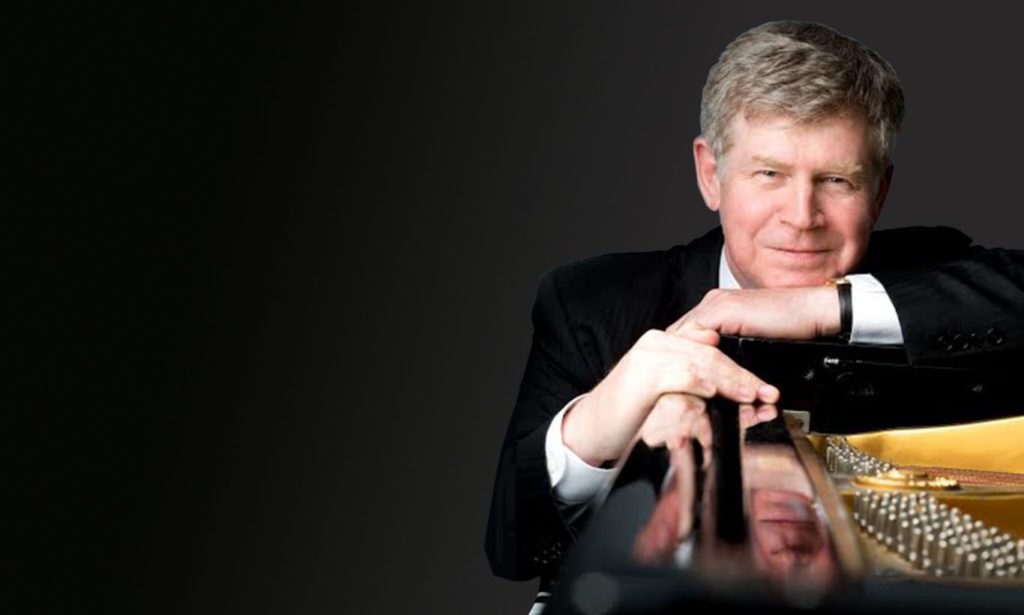All Schumann, all sonatas in Hobson’s energetic recital
When Robert Schumann was born in 1810, Haydn had been dead only a year, and Beethoven would live on and compose for another 17 years. These giants were never far from the young composer’s mind, even as he revolutionized piano music in poetic cycles of short pieces such as Papillons and Carnaval.
That’s why sonatas were on his agenda too, formed in a creative collision between his unruly inspirations and the established forms of old. Friday night’s recital by Ian Hobson at the Tenri Cultural Institute, the third in a multiyear cycle of all-Schumann programs by the pianist, was titled “Sonata Forms,” plural, because no one box could hold all this composer’s ideas about this venerable genre.
Playing with insight and a digital prowess equal to the blizzards of notes Schumann flung across the page, Hobson introduced the 21-year-old would-be sonata composer with an Allegro in B minor (later published alone as his Opus 8), then traced his progress for seven years to the alternate finale he composed for his Sonata no. 2 in G minor, Op. 22.
The composer’s girlfriend and later wife Clara Wieck, already one of the great pianists of the age, had pronounced the first Op. 22 finale “far too difficult.” So of course on Friday, as a finishing touch, pianist Hobson treated the audience to that jaw-dropping piece as well.
Years after this time in his life, Schumann would criticize Chopin’s “Funeral March” Sonata for a lack of unity among its movements, writing that it “simply yoked together four of his wildest children.” Even at 21, he may have considered his sonata movement in B minor too wild a child to yoke into a full sonata, as no more movements followed it.
On Friday, Hobson dove straight into the Allegro’s turbulent, improvisational moods, working motives from the opening cadenza into a froth of variations, and taking due note of the music’s sudden pauses and tender moments. If the texture grew thick in places, obscuring the melodic line, the transformation of the urgent theme from B minor to B major in the closing pages touched the heart as only Schumann can.
There’s something gloriously irrational about a catalogue that includes a Sonata No. 3, Op. 14 and a Sonata No. 2, Op. 22. But that’s how it ended up after Schumann went back and changed and reissued these two works. Hobson continued his survey with No. 3 in F minor, originally a five-movement work with two scherzos. Schumann then dropped the scherzos and called the piece “Concerto without Orchestra,” and much later thought better of that title, adding back one scherzo and christening the four-movement piece “Grand Sonata no. 3.”
Hobson, known for recording complete sets of composers’ works, retrieved the second scherzo as well, and also two discarded variations from the touching central movement, Quasi Variazioni (Andantino de Clara Wieck), incorporating all in this performance for a full view of the young composer’s untrammeled inspiration.
In the first movement, Clara’s theme—essentially a descending scale—rang out through the finger-tangling figurations, and when the composer fell into a pattern of constant dotted rhythms (as he often did in other works), Hobson let them fly, so they never became monotonous.
In the discarded scherzo, Schumann’s persistent defiance of the bar lines (another frequent feature of his works) made for a nearly rhythmless rush of music which Hobson honored. The other, restored scherzo had clearer contrasts between a snappy, rhythmic main section and two mellow episodes, which Hobson could have done more to highlight tonally.
The variations movement swelled with Schumann’s love for Clara, and Hobson let it unfold broadly, with natural accelerations and pullbacks as feelings dictated. The amorous meaning of the impassioned dialogue between the hands in the final variation was unmistakable. The whirling finale, marked Prestissimo possible, was a model of clearly-etched themes in a bracingly fast yet transparent texture.
In his Sonata No. 2 in G minor, Schumann gave his shaggy inspirations a haircut and dressed them in a well-fitting suit of sonata form, much to their benefit in this case. Hobson made sure the eager, impulsive young composer shone through the first movement, marked “As fast as possible” (and later, notoriously, “Faster” and “Still faster”). A memorable theme (Clara’s falling scale again), melodious development section, tight structure, and yes, that Noch schneller coda made for a compelling performance.
The brief Andantino, adapted from one of Schumann’s songs, was a little gem of tender yearning, freely and naturally phrased, which grew a little clattery in the more passionate central episode. The energetic, fist-shaking Scherzo was also brief, relieved by a couple of gently humorous interjections. A fast, crisp rondo finale driven by a steady whir of broken octaves capped this concise sonata.
The sonata’s rejected finale—Schumann’s “Grosse Fuge,” if you will, judged too long and gnarly to fit with the preceding movements—took the place of an encore to Friday’s recital. Hobson played the tarantella-like toccata in 6/16 meter at a blistering Presto passionato, pedaling lightly for maximum clarity, bringing out a snatch of tune here and there, and passing the seven-minute endurance test with flying colors.
The next programs in Ian Hobson’s Schumann series will take place at 7:30 p.m. February 17, 2023 and 7:30 p.m. April 21, 2023 at the Tenri Cultural Institute, 43A West 13th Street.
